Blue Tit Update: after several weeks of frantic activity by the two parent birds until yesterday, today the nestbox is empty and unattended. All the young and their parents have left. They aren’t in sight at the moment: most likely they are not far away, as a family party. There are no signs of predation, and nestboxes mounted high on a wall are in any case very good protection against all our common nest predators.
Monthly Archives: May 2014
The Unchanging Woods, Maybe
You enter the wood — and you might just as well be in the Middle Ages. When I hear people speak of the Dark Ages, I remind myself how in those days the sun shone in just the same way as it does now, and the flowers glittered in woods where there was no difference from what we see today. … Inside the wood we are in the past as well as in the present.
With these thoughts, John Stewart Collis draws his book Down to Earth, now the second part of the combined volume The Worm Forgives the Plough (see my book review) to a close.
And in a way his thoughts from 1947 are still true today: nature is timeless, specially in a wood.
But in another way, the woods of 2014 are very different from those of 1947. The old practice of coppicing is all but dead: a few nature reserves struggle to practise something approaching it; enlightened landowners fell woods in patches rather than clear-felling whole landscapes, approximating the mosaic of new glades, fine old trees, brushwood, young trees and woodland edges bursting with songbirds that characterise true coppice. Often, in the old way of things, coppicing deliberately left behind a few ‘standards’ here and there, fine straight oaks or other hardwoods to grow large timbers for building ships or roof beams. Now, woods are more likely to be managed industrially for timber, or are sadly neglected with ivy on every trunk, brambles all around the forest floor.
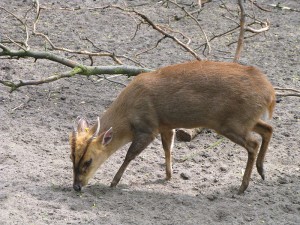
And it gets worse. Where Collis took for granted that woods in springtime saw the primrose, then the bluebell, with here and there an orchid, our wild flowers have declined markedly for reasons to do with human interference. Visitors from the cities pick nice-looking flowers, or dig them up to plant in their gardens. Accidental introductions of deer, especially the Muntjac, graze native flowers down to nothing. Many flowers listed in field guides as common are becoming hard to find outside nature reserves.
Numbers of deer in general, including our native Roe and Fallow, are increasing (and they are spreading into the suburbs) as gamekeeping declines. Since all our large native predators like bear, wolf, lynx, wolverine have long ago been hunted to extinction, there is nothing but human hunting to control deer numbers, and current levels of hunting are insufficient. Maybe George Monbiot is right: our woods need rewilding.
Nature’s Way: Whole Plant Works, Most Active Compound Fails: Why?
The villagers queue in a long line, a hundred or more of them, in front of the traditional healer’s hut in the south of Mali. It is the rainy season, and nearly all of them have malaria.
Chief Tiemoko Bengaly learnt traditional medicine from his grandfather. Perhaps soon nobody will learn traditional African medicine any more, as modern medicine arrives, along with manufactured Chinese herbal medicines.
Bengaly hands out dried Mexican prickly poppy, Argemone mexicana, tells his patients to drink as much tea made from the plant as they can for a week. The parts of the plant have different uses, as it contains powerful toxic alkaloids; the seeds are dangerously poisonous.
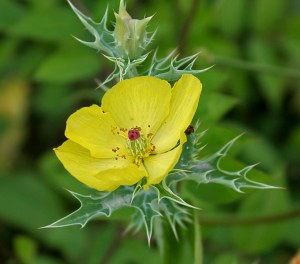
As Brendan Borrell reports in the June 2014 issue of Scientific American (pages 49-53), the results were dramatic: 89% of the patients recovered from their malaria, compared to 95% for the current best treatment for the difficult disease, Artemisinin-Combination Therapies or ACT. The trial was done in 2010 by Dr Bertrand Graz and Dr Merlin Willcox, and their approach was highly unconventional.
ACT consists of a drug obtained from another plant, sweet wormwood, Artemisia annua, discovered by testing plants used in Chinese herbal medicine, in combination with one or more of the many other drugs used against malaria, but which the malaria parasite has invariably developed resistance to over the years. Thus it has come about that ACT has become the last best hope against a slippery, shape-shifting parasite that has defied half a century of work by the world’s biggest drug companies and medical research foundations. All attempts at an anti-malaria vaccine have foundered on the parasite’s ability to change its biochemical spots, while all the drugs have similarly started to fail as the parasite (actually several related species, causing different malarias) becomes resistant, finding ways to continue growing in the presence of chemicals designed specifically to target vital parts of its metabolism.
One of the most remarkable things about the success in Mali – apart, that is, from its very low cost compared to traditional drug discovery, and its use of ethnobotany and a retrospective treatment outcome (RTO) study rather than a double-blind controlled clinical trial (all remarkable features of the work), was this: if the plant had been tested the conventional (I nearly said ‘traditional’) Western way, it would have failed.
The conventional Western approach would have isolated each compound that had any pharmacological activity – in other words, that did anything useful against malaria – and then tested it, alone, “in vitro” (in a test tube) to see how well it worked. It would then pick the most effective one, and try it against malaria in mice, and if that worked well and safely, then try it against malaria in humans.
The most effective substance in Argemone is berberine, and it fails against the malaria parasite. But the whole plant, as administered by healers like Bengaly in Mali, is life-saving.
Somehow, observational study in the style of ethnobotany succeeded where conventional Western medicine’s protocols for drug discovery – clinical trials and all the other paraphernalia for bioprospecting and pharmaceutical research (a jaw-cracking combination of long words derived from Latin and Greek) – would have (or actually) failed.
There is something both humbling and inspiring about this. We humans come from an incredibly clever but stupid species. Alexander Pope had it right:
Born but to die, and reas’ning but to err;
Whether he thinks to little, or too much;
Chaos of Thought and Passion, all confus’d;
Still by himself, abus’d or disabus’d;
Created half to rise and half to fall;
Great Lord of all things, yet a prey to all,
Sole judge of truth, in endless error hurl’d;
The glory, jest and riddle of the world.
Translated, we might read Pope to say “You do your science by analysis, which is hugely effective, but it leaves you prone to endless error, for you are ignoring all the subtle side effects, interactions and combinations of effects that together make up almost everything that is worth having in the world.” Science is not wrong – it is a marvellously precise application of common sense (try whatever it is with the factor X and without, and see what difference factor X makes) – but the world is such a complex place, and the combinations of X and Y and Z and A and B and C are so many, that it will take forever to analyse everything.
In that case, integrated approaches such as traditional herbal medicine, even if they are often somewhat ignorant and wrong in places, have something important to offer. But like many other things that we are accidentally wiping out, like thousands of species of plant and animal in rainforest, ocean, mountain, grassland and marsh, we’d better be quick to study herbal medicine before it vanishes from the face of the earth for ever.
Gypsy Moth plague
The Gypsy Moth, Lymantria dispar, is a notifiable pest listed by DEFRA, or at least it was when that document was published back in 1997. The insect was announced to be “a serious pest of trees and shrubs” and nurserymen and landholders were required to notify DEFRA or the PHSI HQ immediately.
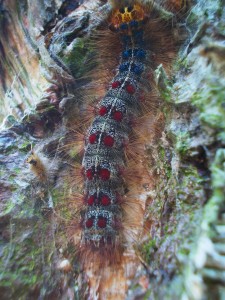
It has arrived in the Gunnersbury Triangle with the hairy dark caterpillar larvae with blue and red warts on their backs all over some Birch trees. The infestation is rapidly defoliating them, and causing substantial damage to some Oaks too.
Lymantria means ‘destroyer’, quite a well-named genus. The caterpillars are aposematic, their hairs and bright coloration warning off predators; the hairs are irritant, containing diterpenes, complex organic ring compounds found in wood and plant resins for defence against microbes and fungi, and retained by the caterpillars for defence against predators.
It will be interesting to see how the trees cope. Oaks can generally recover even when thoroughly defoliated; the Birches may suffer more. People can hardly use pesticides in the nature reserve, even given the means to spray whole trees safely, but biological controls are imaginable. The caterpillars are parasitised by Ichneumon flies, which may well be keeping Gypsy Moths under some sort of control in Europe. There were no controls in place to halt the spread of Gypsy Moth in America, however, where the pest was accidentally introduced in 1869 from Europe by the amateur entomologist Étienne Léopold Trouvelot. He was hoping to cross-breed them with silkworms to improve their disease resistance; he is remembered instead for starting a disastrous continent-wide caterpillar plague which still continues. Attempts with other pest species to introduce their predators or parasites have often proved unsuccessful and sometimes disastrous in their turn.
Giant Ichneumon in London Reserve
A terrifying monster stalks the suburbs. Silently and with unerring accuracy, it scans the surface, using its advanced sensors to detect and identify targets buried deep below. Once a target has been located, the hunter drills down to find it, deposits the payload, and leaves in search of the next. It could be a cyber-borg or pilotless military vehicle. Actually, it’s Rhyssa persuasoria, the giant Ichneumon. And giant or not, it’s about 30mm long.
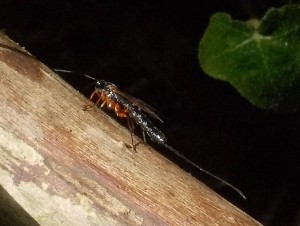
Rhyssa is a parasitic wasp, a solitary hunter distantly related to the social, black-and-yellow striped wasps. Her prey are the larvae of other insects which burrow in dead wood for food and safety. Only when she is above, safety below is hard to find. For Rhyssa‘s weapon is as long as her body: her ovipositor is greatly elongated into a precision instrument that can drill deeply through wood and into the body of the larva. Once there, she lays a single egg down the ovipositor tube. The egg hatches inside the still-living larva, and devours it from the inside. The larva dies (so Rhyssa is a parasitoid, not a true parasite that avoids killing its host) and a young Ichneumon emerges.
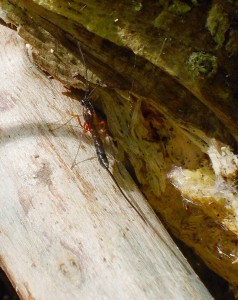
Today at Gunnersbury Triangle we erected a new bench, to allow visitors to relax and enjoy a quiet moment in nature. It sounds a trivial task. If only. Two volunteers spent a day putting the “ready to assemble” kits together. All the supplied bolts were the wrong size, so they had to ream out all the pre-drilled holes to the larger size. Meanwhile, that day, I dug out the well-embedded MetPosts remaining from a previous bench. Then we dug 2 holes for the new bench: they promptly filled up with water, and the deeper we dug, the more the local weakly-cemented gravel (our local rock, when it isn’t sticky clay) collapsed into the hole, making it wider at the bottom. It was clearly hopeless.
So today we spent an hour prospecting for a drier place that would also be aesthetically pleasing, not harm the rare ferns nor disturb the nesting Blackcaps, and be close to an existing path. Then we started digging holes all over again. This time they didn’t fill up with water, much: just the bottom 10 cm or so. To keep the sides from crumbling, we avoided digging with spades: we lay on bin-bags, and wearing rubberised gardening gloves, scooped out handfuls of wet gravel. Then we levelled the two holes, cast a base of PostCrete in each, let it cure — at this point everybody disappeared for a cup of tea, leaving me in the wood guarding the site. I sat on a coppiced Willow trunk, and was approached by the giant Ichneumon when I least expected it. Luckily my little camera was not far away — you can readily imagine why I wouldn’t want the big camera with me while working.
The team reassembled, we gingerly lowered the bolted wooden creation into place, wedged it tight with broken bricks, and fixed it in place with plentiful PostCrete before cunningly sloping the top to shed rainwater. Needless to say, during this procedure we accumulated more and more tools all round the excavation site. If only it were as simple as drilling for an unseen caterpillar and laying an egg in it. But then, Rhyssa has the jump on us, with millions of years of evolution in her hunting technique.
Book Review: Dazzled and Deceived, by Peter Forbes
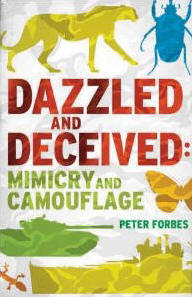
The effect of natural selection on how animals look has attracted the
attention of naturalists from the birth of modern natural history, starting even before Darwin’s Origin of Species.
Visual appearance can affect an animal’s survival in numerous ways.
Camouflage makes it hard for predators to find a prey animal; warning coloration advertises that a potential prey is poisonous or distasteful; Batesian mimicry allows an edible species to pretend to be distasteful; and Müllerian mimicry allows a distasteful species to be sampled less often by young inexperienced predators, by resembling a more common distasteful species. And within these areas, there are infinite possibilities.
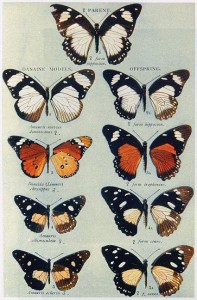
But as the cover art suggests, Forbes does not stop there. Camouflage has military uses; and the history of two World Wars reveals extraordinary interactions between naturalists like Hugh Cott (author of the greatest twentieth-century book on camouflage, Adaptive Coloration in Animals, 1940) and Peter Scott with the military – Scott was a naval captain, so he had a foot in both camps.
Much of the book concerns the natural history and biology of butterflies – they include many of nature’s best mimics, and provide incredibly complex examples of visual evolution at work, as the mimic species adapts to each of the many geographic variants of the host or model species. It’s even possible for multiple forms to appear in a single brood. Forbes describes the research workers, their controversies and their heated opinions, right or wrong. Truth wins in the end, but that doesn’t prevent a messy process along the way, just as in evolution.
Today, new light is being shed on the mechanisms of mimicry and coloration in general by evolutionary developmental biology, which Forbes insists on calling “evo devo”. The result of such inquiry will one day be an explanation of the observed, very complex, natural history at multiple levels – genetics, developmental biology, visual appearance, and natural selection, all of which will have to fit together exactly. Pieces of the puzzle are becoming clear, as in the genetic and developmental mechanisms for producing eye-spots. These can be “impressionistic” – they do not have to mimic a cat’s face, as long as a wing-flash gives a bird predator an illusion of eyes-suddenly-jumping-out-at-me; for we suppose that birds have
an escape reaction triggered in some such way. Thus the explanation must take into account ecology too – the behaviours of both predator and prey are needed to explain why eyespots evolved.
Forbes can’t resist putting an artistic and literary take on the natural
history and science: Sir Ernst Gombrich the art historian was deeply
fascinated by visual illusion, while novelists like Vladimir Nabokov (a keen naturalist) were intrigued by truth and lies. Sometimes the analogies go rather far from natural history (electronic warfare is a case in point: it may be deception but it certainly isn’t visual). But Forbes is always precise, and invariably entertaining.
Buy it from Amazon.com (commission paid)
Buy it from Amazon.co.uk (commission paid)
Book Review: The Wild Places, by Robert Macfarlane

Macfarlane knew Roger Deakin (see my review of Wildwood), and was inspired by meeting him and visiting his extraordinary house. As a young, tree-climbing academic in the distinctly tame countryside of Cambridge, just sitting in the top of his favourite tree outside the city simply wasn’t enough to satisfy his craving for wildness.
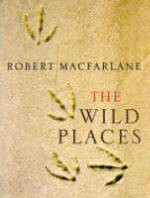
So, for The Wild Places, Macfarlane sets out to the farthest shores of the British Isles, trying both to redraw his map of these islands – not with roads and cities, but coasts and mountains and woods and bogs, linked by ancient footpaths and holloways (roads worn down into the land by centuries of feet and cartwheels), and to define for himself what wildness really means.
In the space of fifteen carefully-crafted chapters, with titles like
Beechwood, Moor, Grave, Holloway and Saltmarsh, Macfarlane introduces us to some of his favourite places, views, treasures – in the form of found stones and shells and bits of wood, in a Deakinesque manner.
Where Jay Griffiths (see my review of Wild) is passionate, even overheated, and Deakin is calm but subtly warm, fiercely rooted in wood, Macfarlane can seem at first rather cold and intellectual: skilful with words, but oddly bloodless. It takes some chapters to start to realize the quality of The Wild Places; a desire to immerse oneself in wildness (both Deakin and Macfarlane favour swimming the wild way, Deakin notably traversing many of our wilder rivers
in his book Waterlog).
There is a plan to the book: around the British Isles, upside down; around the different kinds of wild place – high, low, wet, dry, hard, soft, empty, populated. The last is plainly a surprise to Macfarlane, who travels from an initial rather romantic conception of the places unaffected by man (as if), to places with strong energies of their own, and the people who naturally go with them. There is a bit of dialectic about all this – a thousand student essays on Man vs Nature, perhaps – but it becomes clear that Macfarlane is coming down to earth, and warmth creeps into his writing.
Macfarlane is at his best describing the wonderful diversity of life in the Burren: a rainforest in miniature, in the deep narrow grykes between the clints, the hard, dry exposed slabs of limestone pavement: an endangered habitat if ever there was one. And his love for Coruisk, beyond The Bad Step in the Cuillin Hills of the Isle of Skye, shines out despite any clever word-schemes or devices.
Buy it from Amazon.com (commission paid)
Buy it from Amazon.co.uk (commission paid)
See also Macfarlane’s The Old Ways: A Journey on Foot
Book Review: Wildwood, A Journey Through Trees, by Roger Deakin

Deakin died just after finishing Wildwood, so this book is automatically poignant: not just a celebration of life and wildness, but also an epitaph for this wonderful, crazy, brilliant, down-to-earth
craftsman of wood and words.
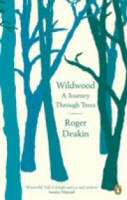
Deakin was very comfortable with wood, and in woods. Indeed there was a timber merchant named Wood in his family, and one of his father’s Christian names was Greenwood, so he tells us. It is at once personal, uncompromising, and captivatingly narrated. There is no academic or intellectual lamentation about how we have lost touch with nature, no vague generalisation: but the truth emerges, clearly and naturally.
He rebuilt his ancient moated house, from a mossed-over, wooded-up ruin, into a lovely, light, airy place: in the process getting to know every one of the 300 beams (“300 trees: a small wood”) that made up the ancient oak frame of the house. He describes the carpenter’s marks on the beams – cut ready to fit together, then transported and assembled on site.
His wanderings about Britain may seem random, but are highly directed: to the places where the Green Man may be found in a dozen churches; to the home of that most English of plants, the Cricket Bat Willow; to the places where those old badgers, Cobbett and Ruskin, protested the injustices meted out to the common man. There is nothing “quaint”, no “folklore” here: just a constant delight in nature, a steady slow-burning fuse of evidence, of hard-won knowledge lightly worn.
Or he shares his visit to the Pilliga forest in New South Wales,
describing in careful but lightly-told detail how the forest of today is not what it seems; how Charles Darwin saw an open park-like woodland, not the dense and lovely tangles that people imagine is the ancient wooded landscape of Australia. He tells from intimate knowledge of the species of trees that used to dominate; of the skill of the Aborigines in managing the land with fire; of the extinction of the local Kamilaroi language, ironically just as the first and last dictionary of that lost tongue was published.
Deakin is not afraid of seeming tame: he is as much at ease telling us about a Bluebell picnic – on a lawn with a woodland view, accompanied by a posse of Cambridge botanists – as roaming the Outback. His knowledge is deep, even encyclopaedic: he collected facts as he collected interesting pieces of wood, stones, feathers – kaleidoscopically. It’s just a pity that there’s no index in the current paperback edition – let’s hope the publisher rectifies this soon.
Wildwood is, quite simply, a delight. You will want to visit the places described; you will look afresh at the wild places you know; and you will be glad that you met Deakin, in the only way that is now possible, through his graceful and supple writing.
Buy it from Amazon.com (commission paid)
Buy it from Amazon.co.uk (commission paid)
See also the review of Deakin’s Notes from Walnut Tree Farm
Book Review: Wild, An Elemental Journey, by Jay Griffiths
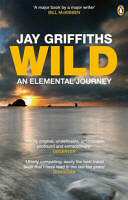
Griffiths gave up her job and sold everything she had to go and spend seven years of her life travelling in the world’s wildest and loneliest places, and living with the rugged, capable and wonderful peoples who still know how to survive in the wild.
In the Amazon, she asks what is the worst thing that could happen to her. La muerte, claro (Death, of course) is the blunt reply. It does not put her off.

The parts of Wild are Earth, Ice, Fire, Air, and Mind. Each one takes
fifty or eighty pages in the telling – and represents a year or more of
Griffiths’ life. It is an astonishing undertaking, indeed truly “elemental”.
Griffiths was a journalist, but in Wild she consciously chooses to abandon “the bounds of my tribe (physical bounds and intellectual bounds)”, preferring “the real outside”. Her descriptions are accurate, but intensely coloured by her experiences – alone on the ice or in the rain forest; in the company of the Inuit, the Aborigine, the Amazon tribes.
She is not afraid of ‘purple prose’ here and there, nor of admitting anger with white man’s racism – the despoliation of Australia, the scorn for “the idea of there being a famously large number of words for snow in Inuktitut”. For there really are many:
“When Igloolik residents were asked for [a] compilation of words for ice and snow, they provided a hundred or so.”
It really shouldn’t be a surprise – skiers know half-a-dozen words (powder, crust, firn or neve, ice, junk, sugar, slush, piste, drift, mogul …) and that is based on far less experience than the Inuit’s.
“Pukakjiujaq is hard snow turning ever so slightly soft; the
best for igloo-building because it will heat faster.”
This is precise knowledge, both on the part of the vanishing Inuit hunters – nowadays they live in heated houses in towns, with freezers and televisions – and on Griffiths’: her journalist’s eye for attributable facts serves her well. Wild is a unique book: passionate, informed, deeply-researched, intellectual, scorched by the earth’s wildest places. It’s not easy to put down.
Buy it from Amazon.com (commission paid)
Buy it from Amazon.co.uk (commission paid)
Vixen Moon
In the evening, the full moon rose between the housetops, a huge, orange-yellow circle, slightly squashed into an ellipse by refraction through the atmosphere. A thin wisp of cloud in the otherwise clear sky gave her yellow glow a ghostly appearance. The moon’s dusty ‘seas’ glowed grey-brown, distinct in outline.
The night was warm. I rose, sticky with sweat, washed, drank, tried to sleep.
A vixen barked, once, twice, faded. I dozed, tried to dream.
The vixen returned, gave her brief yelping bark, louder, nearer, coming closer. I parted the curtain. She was running from left to right along the middle of the road, tail down, nose to ground, shoulders lower than rump, legs moving swiftly in a short trotting gait, grey-brown in the sickly yellow streetlights.
Behind her, on the far pavement, a ghostly shape similar to hers appeared and disappeared, seeming to flicker in the light, vanishing behind the parked cars, more a movement than a shape, her yearling cub, under the vixen moon.
